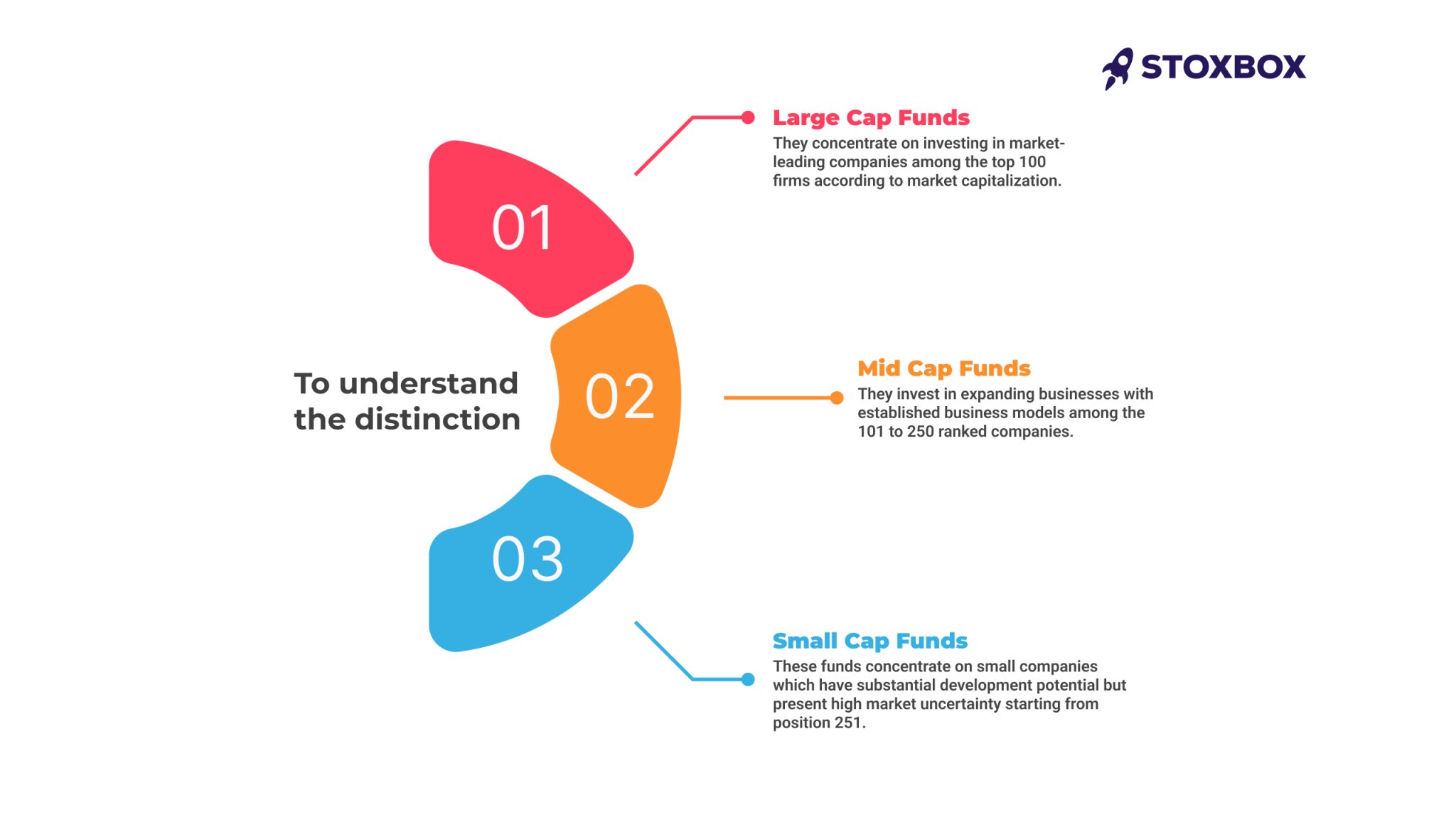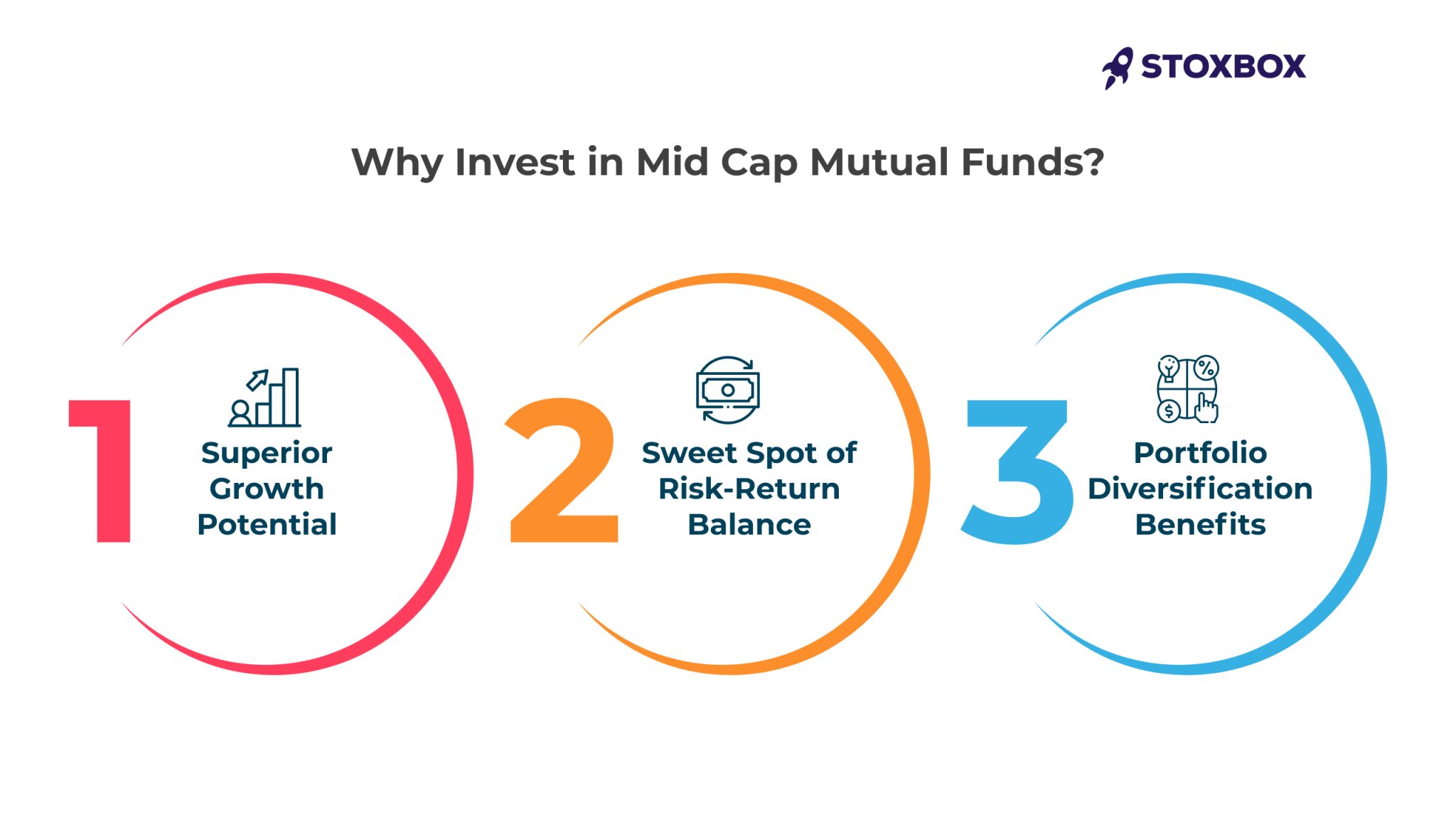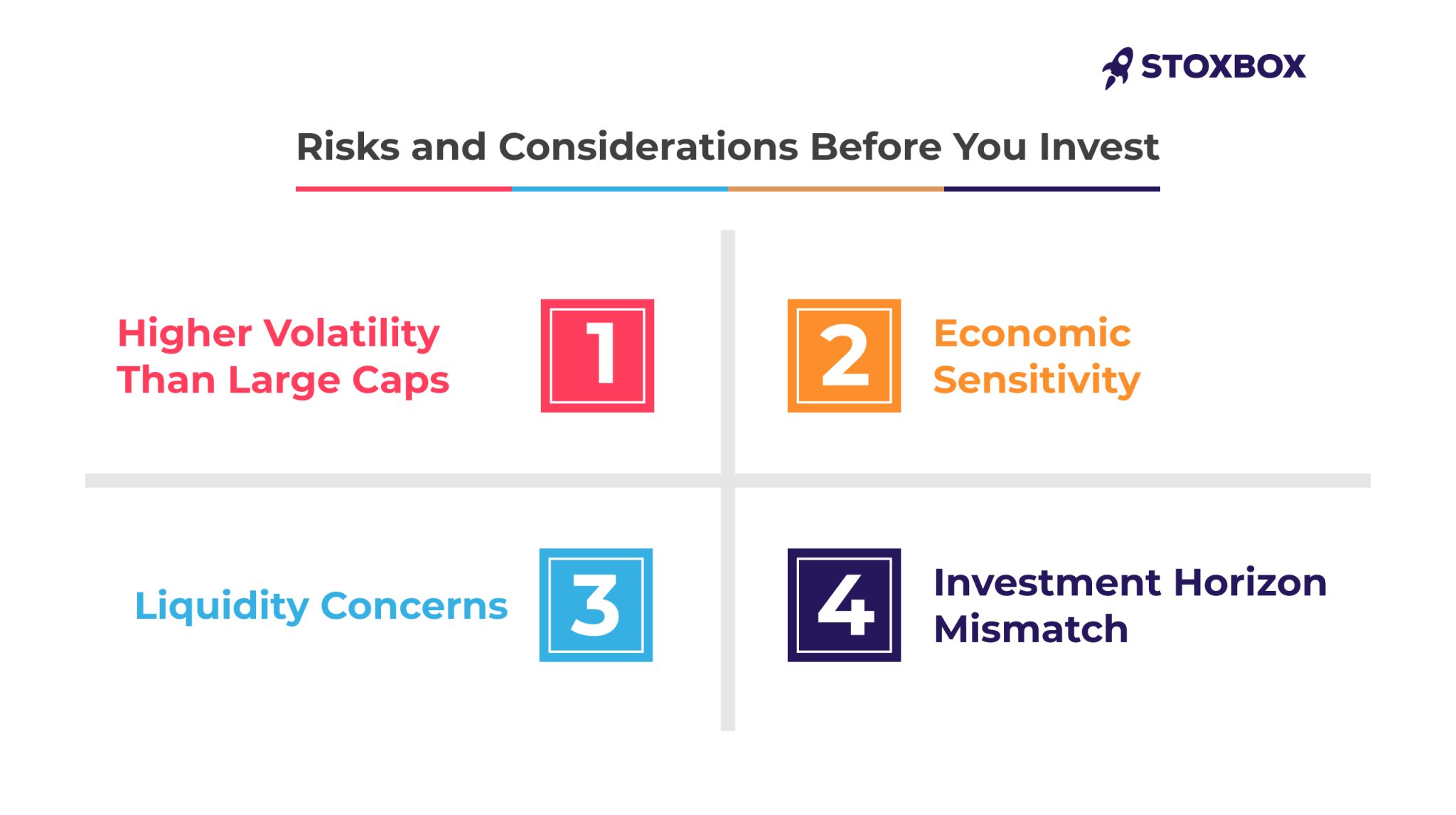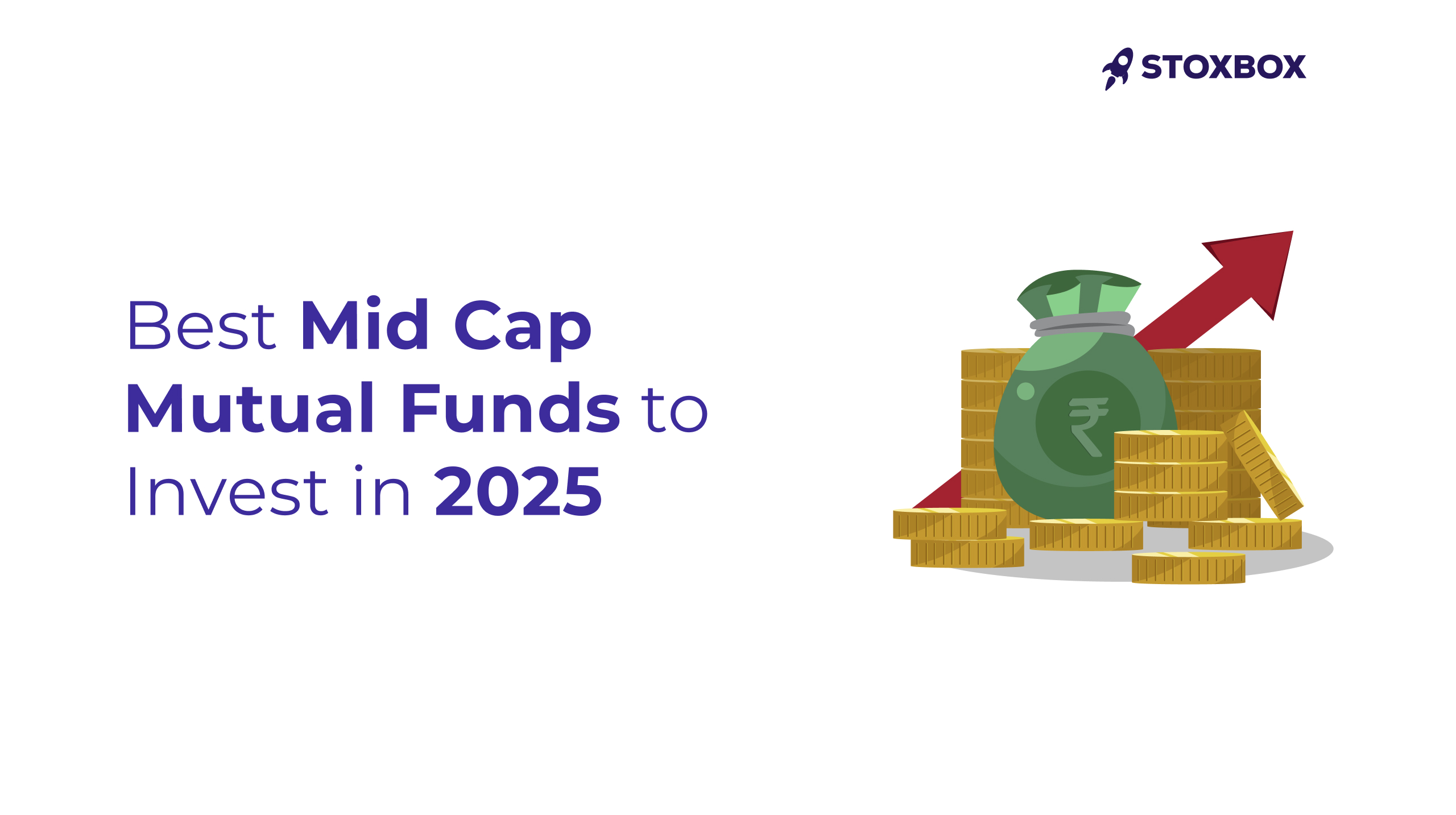Looking to supercharge your investment portfolio in 2025? Mid cap mutual funds might be
your answer. These investment powerhouses have consistently outperformed large cap
funds over the past decade, offering that perfect sweet spot between aggressive growth
and reasonable stability. With the right selection strategy, you can harness their potential to
significantly boost your long-term returns. Nifty Midcap 100 and 150 delivered 23.1%
returns, and Midcap 50 returned 20.8%, all outperforming the Nifty 50’s 8.8%.
This highlights strong midcap outperformance and broader market strength in 2024.
What Are Mid Cap Mutual Funds?
The primary investment objective of mid cap mutual funds is to invest funds in mid market- capitalization companies. The market capitalization criteria established by SEBI divide mid
cap companies between positions.
Mid cap companies fall under the classification of having market capitalization between
₹5,000 crore and ₹20,000 crore. These businesses have finished their high-growth stages but they do not yet possess the established stability and market dominance characteristics
of large-cap companies.

To understand the distinction:
- Large Cap Funds: They concentrate on investing in market-leading companies among the top 100 firms according to market capitalization.
- Mid Cap Funds: They invest in expanding businesses with established business models among the 101 to 250 ranked companies.
- Small Cap Funds: These funds concentrate on small companies which have substantial
development potential but present high market uncertainty starting from position 251.
Why Invest in Mid Cap Mutual Funds?

Mid cap mutual funds provide several compelling advantages which make them an
attractive investment choice for 2025:
Superior Growth Potential
The growth patterns of mid cap companies show better potential than their large cap
counterparts. Business entities in expansion mode allocate their profits toward expanding
into new markets together with product development and operational enhancement.
Sweet Spot of Risk-Return Balance
Mid caps exist in the middle ground between risk and reward in investment portfolios. Mid
cap funds generated higher annual returns than large caps by 2-4% while showing 15-20%
lower price fluctuations than small caps according to historical data.
Portfolio Diversification Benefits
Mid cap funds enable investors to access different industry sectors and expansion catalysts
which are distinct from what large cap funds usually represent. Portfolio diversification
through mid cap funds enables risk reduction and superior risk-adjusted returns.
How to Choose the Best Mid Cap Mutual Funds?
A suitable mid cap fund selection process must consider various essential factors:
Consistent Performance Track Record
The performance of a mutual fund over time helps you gauge its stability and ability to
generate consistent returns. Focusing on 3-year and 5-year return consistency provides
insights into how the fund performs in different market environments.
- Why It Matters: Single-year performance might look attractive but it doesn't give a complete picture. Long-term performance, such as over 3 to 5 years, shows how the fund handles market volatility and fluctuating conditions. A fund that consistently outperforms its benchmark over several years is a sign of solid management and strong stock selection.
- Tip: Review the CAGR (Compound Annual Growth Rate) for both 3-year and 5-
year periods. Ensure that the fund shows consistent outperformance against its
benchmark, such as the Nifty Midcap 150.
Fund Manager Expertise and Tenure
A skilled fund manager with experience in managing mid-cap portfolios plays a crucial role in a fund’s performance. A manager with 7+ years of experience in mid-cap investments is generally better at selecting stocks and timing the market.
- Why It Matters: Mid-cap companies are often volatile, and having an experienced fund manager can help navigate market cycles effectively. An experienced fund manager has a better understanding of market cycles, economic cycles, and sectoral trends, which is essential for making informed decisions about when to enter or exit specific stocks.
- Tip: Research the fund manager’s track record. Look for funds where the manager has demonstrated consistent success over various market conditions, particularly in mid-cap investments. You can also look at the manager’s fund performance during market downturns, as it indicates their ability to mitigate risk during tough times.
Reasonable Expense Ratio
The expense ratio is the annual fee charged by a mutual fund to cover its operating expenses. It includes management fees, administrative costs, and other associated expenses. Essentially, it reflects how much of your investment is being used to maintain the fund rather than being invested for growth.
- Why It Matters: A lower expense ratio means more of your money stays invested and has the potential to grow. Over the long term, even a small difference in the expense ratio can make a significant impact on your net returns, especially for growth-oriented funds like mid-cap mutual funds. For example, an expense ratio of 1.5% can eat into your returns more than a 0.9% ratio over several years.
- Tip: When comparing mid-cap funds, look for funds with lower expense ratios. Even a difference of 0.5% in fees can result in substantial differences in your long-term returns. Direct plans generally have a lower expense ratio compared to regular plans.
Risk-Adjusted Return Metrics
Risk-adjusted return metrics like the Sharpe Ratio, Standard Deviation, and Beta are essential in evaluating a fund’s risk and return profile. These metrics help assess how well the fund compensates for the risk taken.
Why It Matters:
- Sharpe Ratio measures the fund’s return per unit of risk. A higher Sharpe Ratio means the fund is delivering better returns for the same level of risk.
- Standard Deviation measures the volatility of the fund. A high standard deviation indicates higher volatility, which might be acceptable for some investors depending on their risk appetite.
- Beta measures the fund’s sensitivity to market movements. A Beta greater
than 1 indicates that the fund is more volatile than the market, while a Beta less than 1 indicates lower volatility.
Tip: Look for funds with a Sharpe Ratio above 1.0 to ensure you’re getting good returns relative to the risks you’re taking. Additionally, check the Beta value to ensure the fund’s risk aligns with your investment profile.
Exit Load and Lock-in Period
The exit load is a fee charged if you redeem your mutual fund units before a certain period. A lock-in period is the mandatory holding period before you can redeem your investment.
- Why It Matters: These factors impact the liquidity of your investment. A longer lock-in period or high exit load may restrict your ability to withdraw funds without incurring costs. Therefore, if you want flexibility, it’s important to choose funds with reasonable exit loads and shorter lock-in periods.
- Tip: Ideally, choose funds with no exit load or one that is low and applicable only within the first year or two. Also, check the lock-in period for tax-saving funds (like ELSS), but for mid-cap funds, shorter lock-in periods or no lock-in at all are generally preferred.
Assets Under Management (AUM)
The AUM refers to the total market value of the assets the fund manages. A moderate to large AUM generally indicates that the fund has reached a stable and established position in the market.
- Why It Matters: While a high AUM suggests trust and popularity, it can also limit a fund’s ability to invest in smaller mid-cap stocks due to liquidity constraints. On the other hand, a fund that has too small an AUM may not have the resources to manage and grow the portfolio effectively.
- Tip: For mid-cap funds, AUM should ideally be above ₹1,000 crore, as this range ensures operational efficiency while retaining the ability to invest in a diverse set of mid-sized companies. Avoid funds that are either too large (which may impact flexibility) or too small (which may indicate instability).
The Top 5 Best Mid Cap Mutual Funds for 2025
A thorough evaluation of mid cap mutual funds based on their performance consistency,
risk-adjusted returns, fund manager expertise and future growth potential has resulted in
the identification of the top 5 funds for 2025:
| Rank | Fund Name | 3Y Return (%) | 5Y Return (%) | AUM (₹ Cr) | Expense Ratio (%) |
|---|---|---|---|---|---|
| 1 | Invesco India Mid Cap Fund - Direct Plan - Growth | 19.7% | 30.3% | 5247 | 0.7% |
| 2 | Edelweiss Mid Cap Fund - Direct Plan - Growth | 20.1% | 33.7% | 7729 | 0.4% |
| 3 | Motilal Oswal Midcap Fund - Direct Plan - Growth | 23.7% | 35.5% | 23704 | 0.7% |
| 4 | SBI Magnum Midcap Fund - Direct Plan - Growth | 15.6% | 32.2% | 20890 | 0.9% |
| 5 | HSBC Mid Cap Fund - Direct Plan - Growth | 16.5% | 26.4% | 10362 | 0.7% |
Note: The information presented here is valid for 09 th April 2025. The evaluation includes
only direct plans for comparison. The results of past investments do not guarantee future
investment outcomes.
Performance Snapshot: Mid Cap vs Small Cap vs Large Cap
To make proper allocation decisions it is crucial to understand how mid cap funds perform in relation to other categories:
| Category | 5Y Avg CAGR (%) | Volatility | Avg Expense Ratio (%) | Max Drawdown (%) |
|---|---|---|---|---|
| Large Cap | 23.5 | Low | 1.5-1.8 | -10.5% |
| Mid Cap | 31.2 | Medium | 1.8-2.2 | -16.3% |
| Small Cap | 36.4 | High | 2.0-2.5 | -17.8% |
Note: The data is taken as the average of the top 5 MF (according to their AUM). Drawdown is given for the past 6 months
Returns and other data as per the data on 09 th April 2025
Mid-cap funds provide investors with the opportunity to obtain substantial growth alongside
lower volatility than small cap investments.
Risks and Considerations Before You Invest

Mid-cap funds have historically delivered impressive returns — for example, the Nifty Midcap
100 delivered a 5-year CAGR of 35.61%. But they’re also highly volatile. That’s the reality of
market swings.
A Closer Look at the Risks
- Volatility: Mid-cap stocks react sharply to sentiment and economic news. NAVs can fluctuate heavily.
- Liquidity Risk: Lower trading volumes can make it hard to exit without impacting
prices. - Market Risk: These companies lack the depth to withstand downturns like large- caps can.
- Business Risk: Not all mid-cap firms succeed in scaling. Competitive pressure remains high.
- Concentration Risk: Funds may over-allocate to sectors like industrials or chemicals — a weak sector drags the whole fund.
- Economic Sensitivity: Mid-caps react more to interest rate hikes, inflation, and global policy shifts.
- Valuation Risk: Bullish phases can lead to overvaluation and painful corrections.
- Fund Management Risk: Mid-cap funds rely heavily on active stock picking. A misstep can hurt returns.
- Redemption Pressure: Panic selling during market dips can force funds to liquidate assets at poor prices.
- Regulatory Risk: SEBI’s reclassification can impact portfolio composition.
- Credit Risk: Mid-cap firms may have weaker balance sheets, increasing the chance of default.
What You Should Consider Before Investing
- Investment Horizon: A minimum 7–10 years is ideal to ride out volatility.
- Risk Appetite: If you can’t handle short-term losses, reconsider. 2025 is proving especially choppy.
- Diversification: Limit mid-cap allocation to 10–20% of your portfolio. Blend with large-caps and debt.
- Expense Ratio: Often ranges 1.5%–2.5%. Ensure performance justifies the fee.
- Fund Manager Track Record: Prioritize experience across market cycles.
- Exit Load Tax: Exits within 1 year may attract a 1% load; gains over ₹1L after 1 year are taxed at 10% (LTCG), else 15% (STCG).
- SIP vs Lump Sum: SIPs smooth volatility and reduce timing risk. Start with as little as ₹500/month.
- AUM Size: Moderate AUMs (₹1,000–5,000 crore) are better suited for mid-cap agility.
- AMC Reputation: Stick to fund houses with strong research capabilities and risk controls.
Annual Review: Reassess sector exposure, returns, and strategy every 12 months.
Final Thoughts: Should You Invest in Mid Cap Mutual Funds?
Mid-cap mutual funds offer investors a strategic advantage by providing growth potential above large caps and more stability than small caps. Multiple economic growth factors including domestic consumption expansion, manufacturing incentives, financial inclusion
initiatives and digital transformation will positively affect the mid cap segment throughout
2025.
Mid cap funds represent an appropriate investment choice for most investors who want to diversify their portfolios. Consider:
- 1. Core-Satellite Approach: Large caps should serve as your main portfolio investment (60 – 70%) alongside mid caps as secondary investments (20-30%).
- 2. SIP Investment: The strategy of systematic investment into mid cap funds helps protect investors from market timing mistakes
- 3. Long-Term Perspective: A minimum five-year commitment will allow investors to experience the maximum growth potential.
- 4. Regular Rebalancing: Adjust your mid cap allocation when it grows or declines beyond your desired percentage. The patient investor discovers tomorrow large caps at present prices within mid cap funds. Growth-oriented portfolios need these investments because their sweet spot in risk vs return provides essential benefits.
Frequently Asked Questions
1. Which mid cap mutual fund presents the lowest level of risk?
No mid cap fund provides absolute safety because market risks exist by nature, but
Edelweiss Mid-cap fund stands out for its solid performance, experienced management and
strong risk management system.
2. Are mid cap mutual funds risky?
The risk level of mid cap mutual funds stands between large cap funds and small cap funds.
Systematic investment over a period of five years or more together with a long-term
investment perspective helps minimize risk exposure for investors.
3. Which is better: large cap or mid cap?
The investment choice between large cap and mid cap depends on specific portfolio needs
since each type serves different functions. Most people find it beneficial to hold both types
of investments based on their risk tolerance, financial situation and investment timeline.
4. Can I invest in mid cap mutual funds for 1 year?
People should avoid putting their money into mid cap mutual funds for only one year. Due
to their natural volatility, mid cap funds need investors to hold them for at least three to
five years before their growth potential can be fully achieved.
5. Which mid cap fund yielded the highest returns in 2024?
Motilal Oswal Midcap Fund produced the highest return of 57.47% in 2024, outperforming
its benchmark itself. The fund's outstanding performance resulted from strategic sector
positioning and swift entry into emerging themes.
